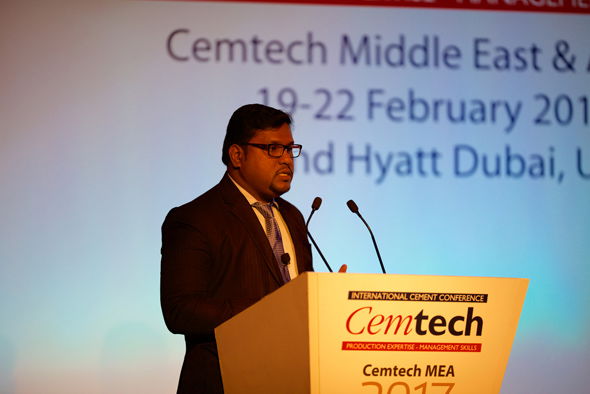Delegates from over 30 countries, including all of the Gulf Cooperation Council's member states, gathered at the Grand Hyatt Dubai, in UAE, for this year's Cemtech Middle East and Africa conference and exhibition.

Santhosh Balakrishnan of Riyad Capital (Saudi Arabia) highlights the demand
drivers and outlook for the Saudi cement industry.
Thomas Armstrong, managing editor of International Cement Review, welcomed guest of honour, His Excellency Sheikh Yasir Bin Ahmed Bin Humaid Al Qassemi, General Manager of Union Cement Company and Chairman of Cement Producers Association of the UAE, and over 200 delegates. In his opening presentation he set the scene for the conference’s 25 presentations by providing a review of global markets and expectations for 2017. He anticipated market growth ex-China to accelerate in 2017, driven by developed economies.
The conference went on to provide delegates with the latest market trends in the region and beyond. Hettish Karmani of Ubhar Capital (Oman) focussed on the latest developments in the Gulf cement sector. Matthias Herles, IHS Markit (Germany), delivered a presentation on he GCC construction markets while Santhosh Balakrishnan of Riyad Capital (Saudi Arabia) considered the demand drivers and outlook for the Saudi cement industry. Dr Lotfali Bakshi of Iran Cement and Mehr Machine Co highlighted new trends in the Iranian Cement Industry.
Moving further afield to Africa as Tony Hadley of Baobab Advisory (France) considered whether the continent’s cement industry is experiencing a calm after the storm. Birla Corporation’s Alok Agarwal, focussed on industry consolidation in the Indian cement sector and the market outlook for the world’s second-largest cement producer.
A business perspective was pursued by UK independent consultant Peter Hoddinott as he highlighted working capital reduction strategies to optimise cement businesses. Jim O’Brien of Jim O’Brien CSR Consulting (Ireland) explained how a cement producer’s efforts in sustainable development benefit the bottomline.
A more technical slant was given to the last part of the day as Dr Suchismita Bhattacharya, Ercom Engineers (India) highlighted the role of slag and fly ash cements in the Middle East. Fernando Dueñas of Cemengal, Spain, provided ways to quickly penetrate booming cement markets while Jawad Baidari of Beumer (Germany) presented two case studies of alternative fuel handling systems.
In addition to numerous presentations, delegates were also able to get first-hand information from some 25 equipment suppliers in the accompanying exhibition.
Cemtech runs until 22 February, bringing the latest trends driving the industry and providing a window to the short- and long-term expectations for the cement sector.
